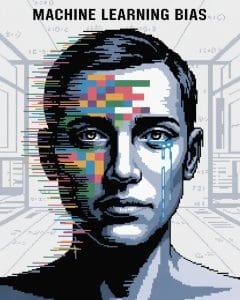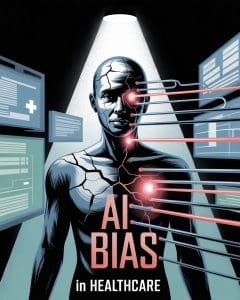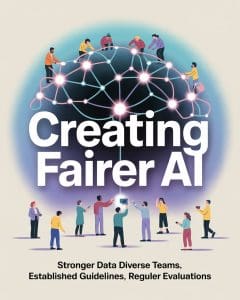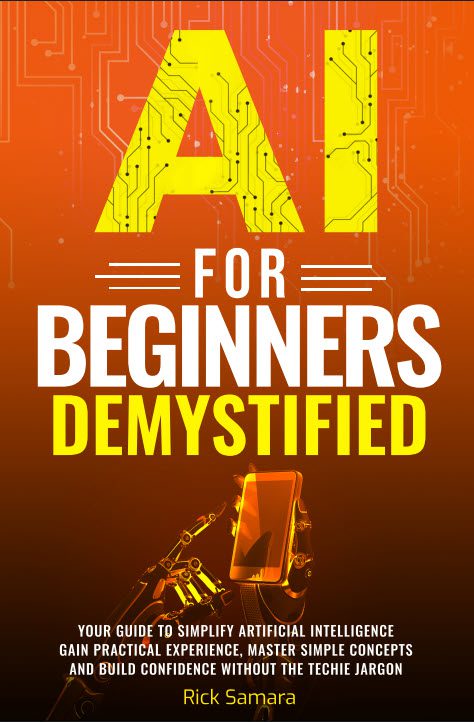 AI bias occurs when artificial intelligence exhibits discriminatory or prejudiced behavior. This is typically a result of the data or rules used to train it. AI bias, also known as algorithmic bias or machine learning bias, refers to the situation where an AI system produces prejudiced or inaccurate outcomes. This is frequently due to deficiencies in the data or design. AI bias is not a technological issue.
AI bias occurs when artificial intelligence exhibits discriminatory or prejudiced behavior. This is typically a result of the data or rules used to train it. AI bias, also known as algorithmic bias or machine learning bias, refers to the situation where an AI system produces prejudiced or inaccurate outcomes. This is frequently due to deficiencies in the data or design. AI bias is not a technological issue.
As a result, it frequently reflects the same biases and deficiencies that are present in the real world. These prejudices can manifest as racial, gender, or even political bias. In practice, this can alter who is approved for a loan.
It can further impact what healthcare gets delivered and what news users are exposed to.
Often, AI bias occurs when the data depicts outdated stereotypes or omits specific populations. This can manifest in algorithms that screen job applicants, assign credit ratings, or recommend articles.
Hear from experts in technology, law, and the social sciences about how bias is influencing outcomes and what actions are most beneficial. Other organizations advocate for fairer AI by conducting data audits, employing transparent methodologies, and conducting regular testing.
To understand what causes bias and how it develops, it is helpful to examine real-world examples and efforts to address them. The following sections unpack these concepts and provide recommendations for more equitable AI.
Key Takeaways
- AI bias stems from bad data, bad design, and human error. Yet, it often reflects broader societal biases, affecting millions worldwide.
- Unchecked AI bias can perpetuate and even exacerbate systemic discrimination. It has significant implications on employment, finance, healthcare, and justice, emphasizing the need for fair and equitable practices.
- AI biases can seep in at many points throughout the AI development process. This ranges from data collection and algorithm design to reinforcement loops that continue to drive discriminatory outcomes.
- To overcome AI bias, we need diverse teams with ethical data practices. We need to audit these systems constantly and be transparent about their decision-making processes.
- Individuals and organizations can contribute by critically evaluating AI outputs, advocating for equitable AI policies, and supporting responsible and inclusive innovation.
- Implementing ethical guidelines and collaborating across disciplines are essential steps to ensure AI technologies serve all communities fairly and effectively.
What Is AI Bias Exactly?
More Than Just Mistakes
In reality, AI bias isn’t just a minor mistake here and there. It has the potential to produce systemic injustice. For instance, many healthcare technologies trained primarily on the data of men can overlook critical milestones and indications of diseases in women.
Facial recognition systems have misidentified people of color at higher rates than white faces. In many cases, these biases manifest when technology fails. They demonstrate the ways AI can amplify human biases on a larger scale.
AI bias can exacerbate pre-existing inequalities. To address this, one key is to understand that AI bias often begins with the human perception of the world.
How AI Bias Sneaks In
Bias can creep into an AI system at multiple stages. It can occur at any stage—with data collection, system design, or model training. When the data is predominantly from one population, the AI learns and makes decisions based on that and may overlook other populations entirely.
Human decisions, such as those regarding what data to include, also allow bias to creep in. At other times, biases can be more insidious at first glance. For instance, an algorithm could learn behaviors that reflect societal biases or behaviors, such as the bandwagon effect or confirmation bias.
The Invisible Influence
The often-unseen nature of AI bias can make it challenging to identify. Because algorithms can appear to be neutral, this bias can be easily concealed. Implicit bias, or the unconscious attitudes that individuals may not be aware of within themselves, is a powerful force that influences the mechanisms of our systems.
This AI bias affects a wide range of outcomes, from the results returned by an image search to bias in hiring tools. Recognizing these invisible influences is the first step towards more equitable AI.
AI bias has the potential to alter a person’s perception or behavior without their awareness.
Unveiling AI Bias Types
AI bias manifests in a variety of ways, influenced by how these systems are trained, developed, and monitored. It almost always begins with the inputs—data, how you set up the methods or algorithms, or human decisions.
How each type of bias affects outcomes Each type of bias affects outcomes in unique ways, often with substantial real-world risks. These biases don’t operate in isolation—they compound, causing greater harms when unmitigated. Here’s an overview of the primary types.
1. Biased Data Input
When the data used to train AI contains the same prejudices or stereotypes of the past, it perpetuates those inequities through AI. For instance, machine learning tools deployed in hiring or in the justice system tend to function more effectively for white individuals compared to people of color.
In another study, an AI tool performed better on men’s faces compared to women’s. They exhibited significantly poorer accuracy for darker-skinned women. If a dataset excludes entire populations or is biased in favor of one population, results will be biased.
Accordingly, it is imperative that AI is trained on broad, equitable datasets.
2. Flawed Algorithm Design
 Flawed design in how algorithms are constructed can amplify or obscure bias. If fairness isn’t built in from the very beginning, bias easily seeps in. Without any oversight or definitive guidelines, this can lead to biased results.
Flawed design in how algorithms are constructed can amplify or obscure bias. If fairness isn’t built in from the very beginning, bias easily seeps in. Without any oversight or definitive guidelines, this can lead to biased results.
For example, certain hiring or loan applications have discriminated against younger or female candidates. This means developers should employ fair, transparent practices from the outset.
3. Human Oversight Issues
Human oversight is crucial for AI to detect bias. If teams do not have the breadth, or do not play the long game with continuous testing, bias will remain undetected.
When it comes to bias, human bias always trumps data or algorithm bias. Continuous audits and diverse teams can better identify and address these failures.
4. Societal Reflection Problem
AI tends to replicate the biases that exist in the world. In fields like law or healthcare, this translates into discriminatory decisions.
In one case, these systems incorrectly flagged twice as many Black defendants as white ones for high risk. Addressing this will require addressing broader societal inequities, beyond technology alone.
5. Bias Reinforcement Loops
Bias can reinforce itself. If the system’s biased output is then fed back in as input, the issue compounds. This is a dangerous bias in hiring tools or criminal justice applications, where historical bias influences future decisions.
Breaking these loops requires proactive interventions and more diverse data.
AI Bias: Real-World Harm
AI is influencing decisions in employment, finance, health, and criminal justice, but when biased AI systems introduce algorithmic biases, the harm is real and often disproportionately affects marginalized communities. This section will address specific instances where racial bias and other forms of inherent biases in AI are altering real lives, emphasizing the importance of managing bias.
Job Opportunities Lost
These biased hiring tools can shut out equitable opportunities for employment. Consider how many companies are using AI to screen job applicants today. When these systems learn from retrospective data that embodies previous biases, they tend to discriminate against marginalized groups.
For example, AI-driven resume screeners may eliminate women from tech jobs as long as the gender of past hires was male. In other instances, people who use adaptive technologies or have names associated with minority cultures are overlooked. This pattern continues to shut out tremendous talent and limit diversity.
Common-sense, fair hiring rules and open algorithms can go a long way. Companies should ensure that AI does not discriminate against or disenfranchise individuals based on their race, gender, or socioeconomic background.
Financial Access Denied
AI determines who is approved for a loan, a credit card, or a bank account. These biased credit scoring tools may disproportionately rate certain racial and ethnic groups lower due to biased data inputs or biased tool design. This can prevent individuals from receiving the capital needed to launch a new venture or acquire housing.
Marginalized groups, such as people of color or immigrants, primarily feel this harm. We need fair and clear rules and checks to ensure that these problems don’t recur. Regulators need to hold these systems accountable to ensure that they’re equitably serving all communities.
Healthcare Disparities Worsen
 In health care, bias in AI has real-world implications, resulting in incorrect or delayed care. Computer-aided diagnosis tools will inherently fail to be accurate for African-American patients. This occurs, for example, when the training data did not cover sufficient instances from this population.
In health care, bias in AI has real-world implications, resulting in incorrect or delayed care. Computer-aided diagnosis tools will inherently fail to be accurate for African-American patients. This occurs, for example, when the training data did not cover sufficient instances from this population.
As a result, this leads to misdiagnosis or delayed diagnosis. AI in healthcare must be based on comprehensive, representative data with bias testing to ensure equitable care for all patients.
Justice System Inequity
AI tools in courts and police work can deepen unfairness. Facial recognition tech often misidentifies people of color, leading to wrongful arrests. Some risk assessment tools used in courts can rate certain groups as higher risk, not because of facts, but due to biased past data.
Open, fair checks of these systems matter most. Reforms and clear rules can cut down the risk of unjust outcomes.
Why AI Systems Falter
Bias is one of the most heavily documented reasons biased AI systems fail in real-world environments. These problems arise in data collection, training, algorithm design, and even within the teams that develop the systems. Every step must be taken with diligence to prevent unfair outcomes and ensure that AI serves us all equitably and efficiently.
Problematic Data Gathering
AI’s success relies on high-quality data, but acquiring equitable and representative data poses a significant challenge. Many AI imaging models use data from just a few locations. One systematic review found that most imaging studies relied on data from only three U.S. States, allowing other states to be excluded entirely.
Even large and diverse datasets such as the UK Biobank do not represent everyone. Like many genomics projects, only 6% of patients are of non-European ancestry. When data is scarce or too narrow, AI may overlook important groups, resulting in biased outcomes.
Ethical data practices—clear consent, respect for privacy and anonymity, and broad sampling—are useful, but aren’t always implemented. Improving data collection begins with asking the hard questions: who is included in the data, and who is not.
Skewed Training Information
In the absence of a real-world equivalent, AI models often perpetuate outdated trends. They might reinforce existing stereotypes. In a systematic review of chest X-ray datasets, less than 9% indicated race or ethnicity.
This lack of public oversight hinders the detection and mitigation of bias by third parties. Whether it is through routine audits or frequent updates of these datasets, bias can be lessened and accuracy increased. Providing AI systems with diverse, well-vetted data sets sets them up for more equitable outcomes.
Algorithmic Blind Spots
Without thorough testing, algorithms can overlook relevant factors. Take, for instance, the AI tools used in hospitals that failed to consider racial disparities in ICU outcomes. Without rigorous testing, models can continue to perpetuate the same errors.
Constant testing and revision allow us to identify these blind spots, helping to eliminate AI bias.
Homogeneous Creator Teams
If those creating AI systems all come from the same background, they may overlook issues that others would identify. By creating diverse teams that can identify risks and experiment with new ideas, we can ensure safer, fairer AI.
It’s a simple equation—more diverse voices in the room lead to better solutions that work for a broader range of people.
Strategies for Fairer AI
 Creating fairer AI requires a combination of stronger data, more diverse teams, established guidelines, and regular evaluations to address bias in AI. AI bias often stems from three primary sources: the data used, the code’s functionality, and user interactions. A single solution won’t resolve all issues. To combat this, teams must understand where algorithmic biases can emerge and take a comprehensive approach to prevent biased results.
Creating fairer AI requires a combination of stronger data, more diverse teams, established guidelines, and regular evaluations to address bias in AI. AI bias often stems from three primary sources: the data used, the code’s functionality, and user interactions. A single solution won’t resolve all issues. To combat this, teams must understand where algorithmic biases can emerge and take a comprehensive approach to prevent biased results.
Improve Data Practices
Better data is what’s needed to make AI work for everyone. When only specific demographics are represented in the training data, it can lead to potentially harmful outcomes. Consider that facial recognition technology is much less successful at accurately identifying darker-skinned women as compared to white men.
The use of comprehensive data that includes individuals from diverse racial and socioeconomic backgrounds helps combat this. Quality-diversity algorithms can even be used to create these rich data sets when access to real data is difficult. Teams need to be transparent about the origin of their data.
They need to commit to regularly auditing it to ensure it remains up-to-date and fair.
Diversify AI Creators
AI works particularly well when a diverse range of perspectives creates it. When teams are diverse, they not only identify issues but also offer novel solutions. Organizations must support individuals from underrepresented communities in the technology sector.
This is crucial for developing AI tools that genuinely serve the needs of our diverse society.
Demand AI Transparency
The public deserves to know how AI arrives at its decisions. Trust comes from sharing how systems work. Releasing this information publicly and disclosing who audits these systems keeps developers accountable.
Open reporting is the first step; without standards, we don’t know what we’re comparing.
Implement Ongoing Audits
Regularly auditing AI systems is a proven method for identifying and eliminating bias that may be lurking beneath the surface. Having outside experts review them injects a level of trust and independence, which will help keep teams honest.
Ongoing audits establish trust, allowing organizations to address issues more proactively and maintain their commitment to fairness.
Adopt Ethical Guidelines
Ethics inform every decision made in AI research and development. The industry should create and enforce standards for fairness, drawing on international examples such as UNESCO’s Recommendation on the Ethics of AI.
international examples such as UNESCO’s Recommendation on the Ethics of AI.
Ethics are a guiding light for teams to work toward and a shield against losing the public’s trust.
Your Part in Ethical AI
As AI continues to shape our daily lives, from our social media feeds to hiring tools, its impact is undeniable. For this reason, we all have a part to play in demanding equitable and ethical AI. Now, with AI, technology is moving at lightning speed!
When someone uses AI for the first time, it’s often difficult for them to identify its shortcomings immediately. AI bias often seeps in when data sets are unbalanced. It could just as easily happen when the people creating the algorithms use their own judgment to make decisions informed by their beliefs.
These problems manifest the most when teams are not diverse or when the process is too rushed for proper ethical safeguards to be made.
Critically Assess AI Outputs
It’s helpful to examine AI results with a critical eye. Reading an AI-written article, for example, means checking for slants or missing views. AI bias can emerge if the data is skewed or if the rules underlying the AI reflect outdated ideas.
Asking “Why did the AI make this choice?” lets consumers spot where fairness might be lacking. People who understand AI’s limitations can ask intelligent questions, making the technology better for everyone. A habit of second-guessing AI, much like double-checking facts, can lead to stronger trust and better results.
Champion Fair AI Rules
How you can help Humans create AI, not only by using it, but by supporting fair rules. Whether laws or corporate policies, these initiatives are most effective at reducing bias when they prioritize fairness and seek diverse input.
You can join them by supporting those fighting for fair AI rules. When you speak up to decision-makers, you’re not just standing up for yourself. Even seemingly minor actions, such as voicing ethical concerns to your colleagues, are crucial in establishing a baseline of accountability for all.
Back Responsible Innovation
Supporting equitable AI involves questioning whether each new development actually benefits everyone, or whether it’s doing more damage. Supporting and investing in technology that prioritizes everyone—regardless of race, ethnicity, or income—will hold companies accountable to improve.
When industry and communities work together, we can help develop AI that addresses real-world needs. This collaboration further serves to mitigate bias. Whether it’s choosing what technologies to adopt or what research and development to support, every decision being made today determines the future.
Conclusion
 AI has tremendous potential to impact lives, but bias in these systems creates very real impacts on individuals. Concrete measures, such as increased openness through data and equitable auditing, can go a long way to eliminate biased defects. The teams building AI and those using it must remain vigilant for bias and rectify it at the outset. Even small actions, such as submitting public comments or asking questions, can help move the needle in a positive direction. From news stories that demonstrate bias emerging in health, employment, and everyday technology, the work is ongoing. Each individual member determines the next step. To help AI remain equitable, continue the conversation with your peers in your workplace and on social media. Have suggestions or feedback for us? Comment, raise hell, and join the fight to make real, positive change. Remember, every step counts!
AI has tremendous potential to impact lives, but bias in these systems creates very real impacts on individuals. Concrete measures, such as increased openness through data and equitable auditing, can go a long way to eliminate biased defects. The teams building AI and those using it must remain vigilant for bias and rectify it at the outset. Even small actions, such as submitting public comments or asking questions, can help move the needle in a positive direction. From news stories that demonstrate bias emerging in health, employment, and everyday technology, the work is ongoing. Each individual member determines the next step. To help AI remain equitable, continue the conversation with your peers in your workplace and on social media. Have suggestions or feedback for us? Comment, raise hell, and join the fight to make real, positive change. Remember, every step counts!
Frequently Asked Questions
What is AI bias?
AI bias occurs when an AI system produces discriminatory or biased outcomes, often resulting from biased training data or algorithmic biases that reflect existing societal biases.
How does AI bias impact real-world situations?
AI bias, including racial bias and gender biases, can cause discrimination in fields such as hiring, healthcare, and law enforcement, injuring communities by depriving them of equal chances.
What are the main types of AI bias?
The three primary examples of AI bias include systemic biases, racial bias, and gender bias.
- Data bias comes from bad data.
- Operationalize algorithmic bias. Algorithmic bias happens in the design of the system.
- Societal bias is the result of pre-existing societal inequalities.
Why do AI systems make biased decisions?
AI systems train on data produced by people, and if this data contains biased content, such as racial bias or gender biases, the AI can learn and replicate those same biases in its outputs.
Can AI bias be prevented?
Can AI bias, including inherent biases and biased data collection, be prevented by using better data? Test regularly for fairness, encouraging input from diverse experts throughout the development process!
What can individuals do to promote ethical AI?
Get involved and continue to question AI’s role in decision-making, especially concerning biased AI systems. Support legal scholars and advocacy organizations that are fighting for transparency, accountability, and fairness in AI!
Why is it important to address AI bias?
This is why it’s so important to address AI bias, including systemic biases and implicit biases, to ensure that all people are treated fairly and equitably, fostering trust in technology and producing better outcomes for society.


